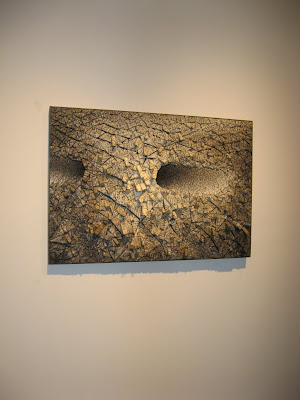Kwang-Young Chun’s compositions are constructed of hundreds of tiny triangles wrapped in century-old handmade mulberry paper. Using a range of gray to black tones, Chun creates what looks like deep depressions or craters. He fabricates small triangles out of Styrofoam and then wraps them with mulberry paper. He then fastens these objects with string to a canvas, creating make-believe surface relief by appropriately patterning the triangles. These deep depressions are not actual indentations but are a result of the triangles coalescing into an illusion of depth.
For those unfamiliar with Korean culture, the mulberry paper used in these compositions offers an additional layer of meaning. In pre-modern Korea, herb medicines were wrapped in white mulberry paper and were then hung along ceiling rafters of family run pharmacies to prevent dampness and to keep away insects. Like the Ayurvedic medicines of India that are falling into slow obscurity, the herbal medicines of pre-modern Korea are also falling into disrepair.
I found the following page on artnet that shows a little more of his works:

----------------------------------------------------------------------------------
The original reason for going to this gallery was to see the audio/sculpture art of Scott Sherk. I was not that impressed, but if you want to read about it, please see here. I have a picture below.
 Scott Sherk began with the idea that he could find a visual and aural way to document an interesting walk. Recording the walk with both a stereo recorder and a GPS tracking system led Sherk to the realization that the act of walking was itself a drawing in space. This drawing – his walking – could be represented three dimensionally in sculpture. Back in the studio he transformed GPS information that recorded his path and elevation into welded steel forms. He edited his field recordings from his stereo to accompany the sculptures. Together, these works become an installation of soundscape and landscape.
Scott Sherk began with the idea that he could find a visual and aural way to document an interesting walk. Recording the walk with both a stereo recorder and a GPS tracking system led Sherk to the realization that the act of walking was itself a drawing in space. This drawing – his walking – could be represented three dimensionally in sculpture. Back in the studio he transformed GPS information that recorded his path and elevation into welded steel forms. He edited his field recordings from his stereo to accompany the sculptures. Together, these works become an installation of soundscape and landscape.
 Scott Sherk began with the idea that he could find a visual and aural way to document an interesting walk. Recording the walk with both a stereo recorder and a GPS tracking system led Sherk to the realization that the act of walking was itself a drawing in space. This drawing – his walking – could be represented three dimensionally in sculpture. Back in the studio he transformed GPS information that recorded his path and elevation into welded steel forms. He edited his field recordings from his stereo to accompany the sculptures. Together, these works become an installation of soundscape and landscape.
Scott Sherk began with the idea that he could find a visual and aural way to document an interesting walk. Recording the walk with both a stereo recorder and a GPS tracking system led Sherk to the realization that the act of walking was itself a drawing in space. This drawing – his walking – could be represented three dimensionally in sculpture. Back in the studio he transformed GPS information that recorded his path and elevation into welded steel forms. He edited his field recordings from his stereo to accompany the sculptures. Together, these works become an installation of soundscape and landscape.

2 comments:
I love the technique of the Korean artist and the symbolism. The picture of his work is really stunning.
It seems very simple at first but the complexity of it really is quite stunning.
Post a Comment